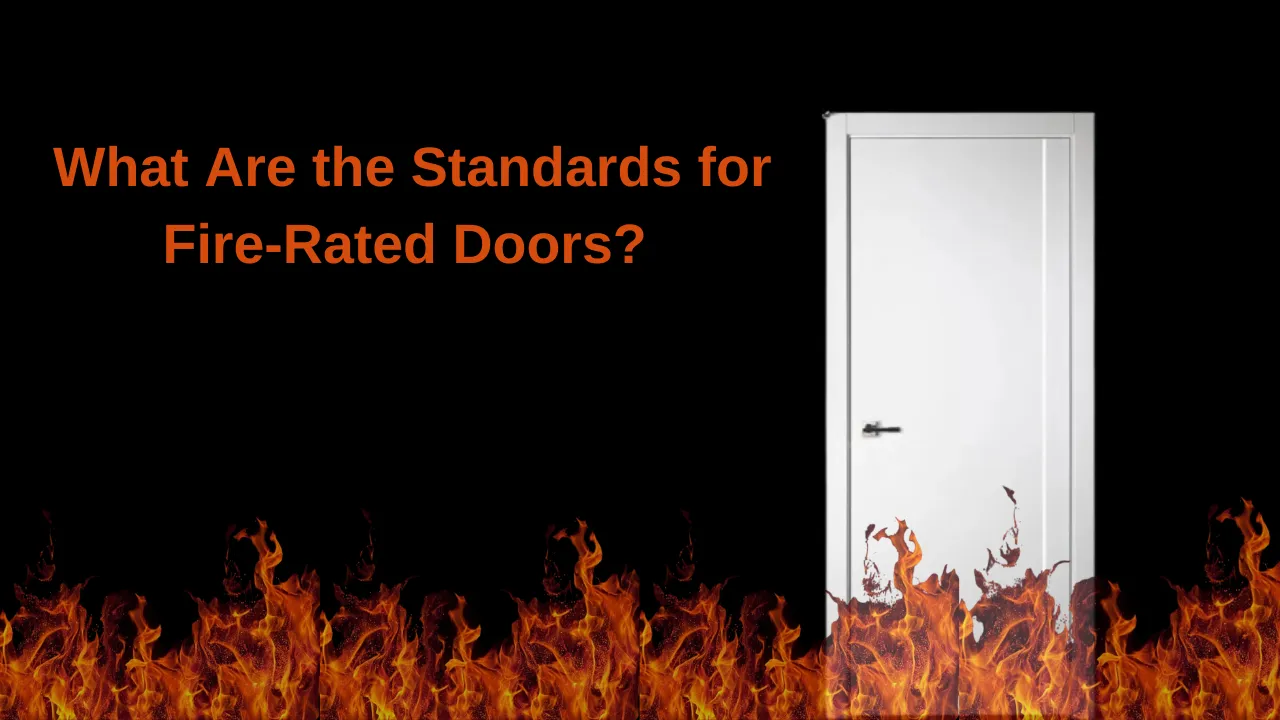Fire-rated doors are crucial to a building’s structural integrity. These components are designed to slow the spread of fire, smoke, and toxic gases.
In this article, we will explain the standards and regulations that fire-rated doors must follow, covering everything from testing criteria to required features.
Understanding Fire-Rated Doors
A fire-rated door has been tested and certified to withstand fire for a certain period, ranging from 20 minutes to 3 hours. These doors are installed in areas where fire containment is critical, such as exits, stairwells, and corridors. They can play a crucial role in safe evacuations and fire management.
Why Do Fire-Rated Doors Matter?
Having a fire rated access door or a fire-rated door is not just about following the regulations. When installed correctly, they create fire-resistant compartments within buildings that limit the spread of fire and give occupants more time to escape.
Key Standards for Fire-Rated Doors
Let’s have a look at some key standards and guidelines that are widely followed for fire-rated doors:
1. UL 10B and UL 10C (U.S. Standards)
UL 10B is a traditional method of testing fire door assemblies under positive pressure, establishing foundational criteria for door performance. Building upon this framework, UL 10C introduces enhanced testing parameters that simulate realistic conditions. It provides a more comprehensive evaluation of door assembly performance in actual environments.
Generally, doors tested to UL 10C are often used in buildings where modern fire codes are enforced.
2. NFPA 80 (National Fire Protection Association Standard)
The NFPA 80 standard provides comprehensive guidelines for installing, maintaining, and inspecting fire-rated door assemblies. This standard is crucial as it outlines detailed requirements for all door components, including hinges, latches, and frames, ensuring they meet the necessary performance criteria.
3. BS 476 and BS EN 1634 (British Standards)
The BS 476 establishes rigorous testing protocols for various building components, with specific provisions for fire door assemblies. Complementing this, BS EN 1634 serves as the European standard, providing comprehensive guidelines for testing both door and shutter assemblies.
4. ISO 3008 (International Standard)
The ISO 3008 standard is a global benchmark for fire door assembly testing procedures. This comprehensive standard outlines specific testing methodologies and performance criteria that manufacturers must meet for international certification. It provides detailed protocols for testing fire resistance, ensuring consistency across different countries and regions.
5. IBC (International Building Code)
The International Building Code encompasses a detailed set of regulations that govern the design and installation of fire-rated doors in various building types. These guidelines consider multiple factors, including building occupancy classification, door location within the structure, and specific usage requirements.
Each standard plays a crucial role in setting performance benchmarks. Fire doors are tested rigorously to ensure they hold up under extreme heat and prevent fire from spreading.
Common Features of Fire-Rated Doors
Fire-rated doors come with specific features that enhance their fire resistance:
- Fire-Resistant Core Material: Core materials include gypsum, steel, or mineral cores that provide insulation and prevent heat transfer.
- Seals: Intumescent seals expand when exposed to heat, filling gaps around the door frame to create an airtight barrier that prevents smoke from passing through.
- Automatic Closers: Fire-rated doors are equipped with a self-closing mechanism—a spring hinge or door closer—that ensures the door automatically closes to contain the fire.
- Reinforced Frames: The frame must be equally fired-rated to support the door’s structure in an emergency.
Different Types of Fire Ratings for Doors
Fire ratings signify how long a door can withstand a fire, usually marked in minutes or hours. Here’s a table outlining typical fire ratings and their usage:
| Fire Rating | Usage/Application |
| 20 Minutes | Often used in corridors or stairwells |
| 45 Minutes | Suitable for partition walls |
| 60 Minutes | Common in high-risk areas |
| 90 Minutes | Used in larger buildings or complexes |
| 120 Minutes+ | Designed for highly sensitive areas |
Frequently Asked Questions (FAQs)
Fire-rated doors can be constructed from materials such as steel and aluminum, provided they meet testing standards and include an appropriate fire-resistant core.
Fire-rated doors typically have a label or plate located on the hinge side. These labels indicate the rating, testing standards, and manufacturer information.
Yes, fire-rated doors can have glass inserts. The glass used in them must also be fire-rated and capable of withstanding heat.
How Do Fire-Rated Doors Compare to Regular Doors?
| Feature | Fire-Rated Doors | Regular Doors |
| Fire Resistance | Tested to withstand specific fire durations | No fire resistance |
| Core Material | Fire-resistant materials | Varies, often wood or hollow-core |
| Smoke Seals | Yes, to prevent smoke leakage | Typically absent |
| Labeling | Required for fire certification | No labeling requirement |
| Automatic Closing | Often equipped with auto-closers | Not necessary |
| Application | High-risk areas, exits, stairwells | General room entries and exits |
The Importance of Certified Fire-Rated Doors
Proper certification of a fire-rated door is important for regulatory compliance and effective fire management. These certifications verify that each door assembly has undergone rigorous testing procedures and meets all requirements. They help minimize potential legal and financial responsibilities and increase the safety of building occupants.
For more information on door certification standards, check out this Wikipedia article on fire doors.
Final Thoughts
Understanding the basic standards for fire-rated doors can make a huge difference in a building’s structural integrity. These doors are more than just normal doors: they are critical components that provide safety and security for everyone in the building. From core materials to maintenance routines, every detail matters when it comes to these fire-rated doors.

